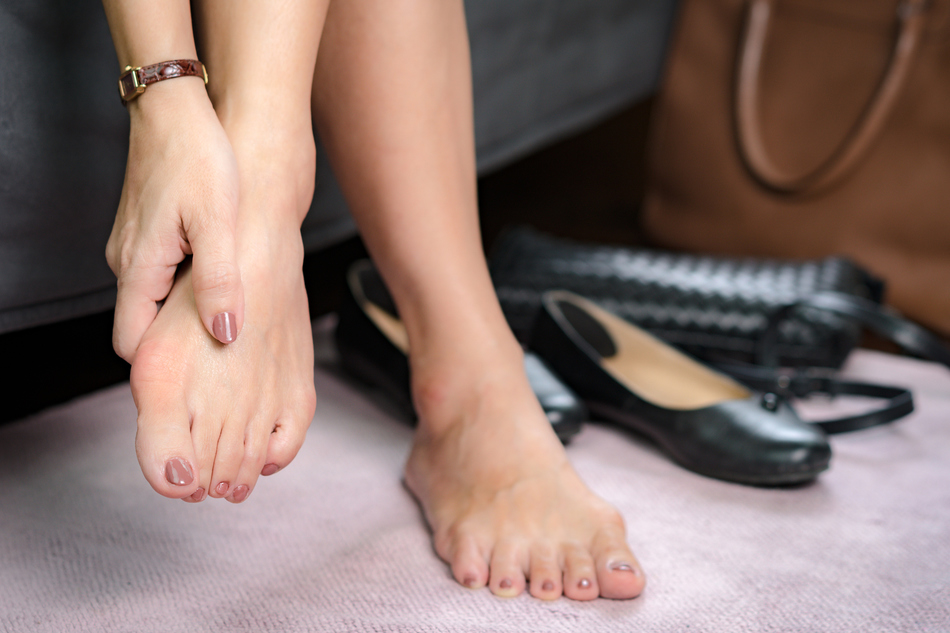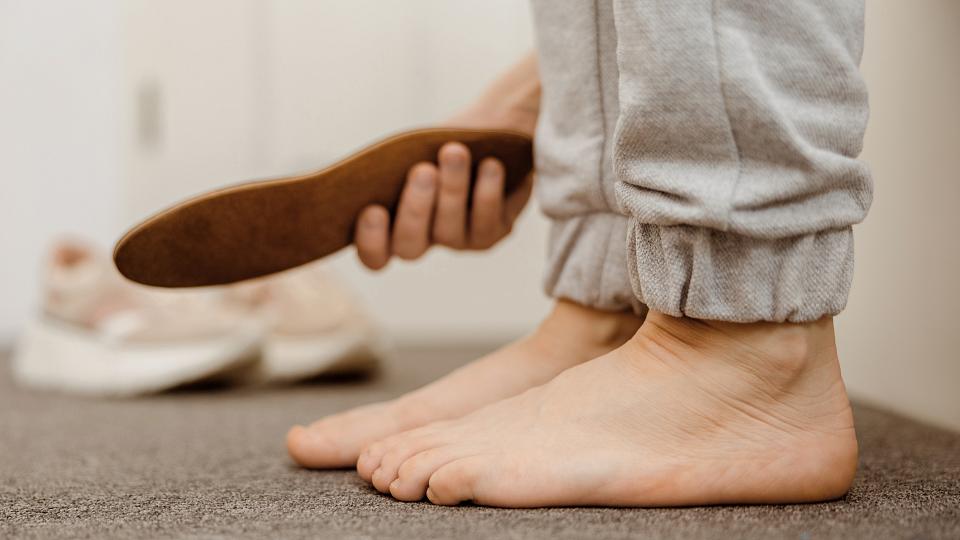
Interviewer: So maybe you or a loved one has a bony protrusion on your foot. It's maybe painful, maybe not. It's a bunion. How exactly does one treat a bunion and what kind of results can one expect from the treatment options?
We're here with Dr. Devon Nixon. He is an orthopedic surgeon at University of Utah Health, with an emphasis on lower extremity, foot, and ankle medicine.
Now, Dr. Nixon, before we kind of go into treatments, let's just start real basic. What is a bunion exactly?
Dr. Nixon: A bunion is an interesting thing that we see really commonly in clinic. It's more than just a bump that's forming on the inside part of the big toe. What's actually happening is there's a complex three-dimensional change that's occurring where one portion of the toe is beginning to move towards the inside, which then drives the big toe part towards the second and third toe. And it may begin to even cross over under those second and third toes.
Interviewer: And is there any way to, say, prevent them?
Dr. Nixon: I wish there was a way to prevent them. They're very common, and certainly not everyone with a bunion needs surgery. And so there are plenty of things to do to try to make them more comfortable, like modifying your shoes or adding a toe spacer. But unfortunately, those options don't necessarily change the long-term progression, which is that the bunion may slowly increase over time.
Interviewer: So let's go back a little bit with that. When you're talking about treatments, you said it's not necessarily surgery. If we're not doing surgery, what are the other options available, and what are you actually treating with those?
Dr. Nixon: Like most things in my practice and in most orthopedic practices, there are nonsurgical and surgical treatments. And the nonsurgical things that many patients choose to do are to add some modifications to their shoes. So they get them in wider forms to help reduce some of the irritation on the inside part of the big toe, which, for many patients, is one of their biggest pain drivers.
Another thing is they can add over-the-counter gel inserts that slide between the big toe and the second toe to help push the toe a little bit out of the way to make it more comfortable.
And those are all driven based on symptoms. So the choice of whether or not to move forward with surgery is a patient-driven choice. It's certainly not one that I will make for them. My goal is to help them have the information they need to make the right choice.
But the options after modifying your shoes and adding an insert, there's not a lot of in-between. So, unfortunately, the conversation may then move towards, "What are my surgical options?" which are to help get the toes straighter and to help remove the bump.
Interviewer: So let's move on to those surgical options. As an orthopedic surgeon, any time a patient hears the word "surgery," there's a little bit of anxiety. There's a little bit of weighing the risks and benefits. Kind of walk us through the surgery. Not necessarily the nuts and bolts of everything, but as a patient, is this an outpatient procedure? How long can I expect to recover, etc.?
Dr. Nixon: Absolutely. I mean, I'm a surgeon, but I'm extremely sensitive to the fact that no one wants to go through surgery. And my job will never be to sell anyone on the surgery. It's the patient coming in to tell me that this is what they think is the best option for them. They feel like they've tried these other things.
And then the different technical options for surgery vary from patient to patient. So it's driven by a lot of factors, some of them clinical, some of them on the X-ray, some of them very patient-specific.
But largely, what we're doing is we're trying to correct the bunion by straining the big toe. And you can do that by either cutting the bone and shifting it. We call that an osteotomy.
You can fuse certain joints around the big toe. So one of them is fusing a joint closer to the middle of the foot, and we call that a Lapidus procedure.
And then another procedure is, depending on the patient, if they have some arthritis that's developed, you can fuse the actual big toe joint itself.
But a lot of these decisions of what to do from a surgical perspective are not uniform to everyone. So that's a conversation that we all have in clinic. If patients feel like they're at a surgical level, I look at the X-rays, I talk to them, get a good history, understand their activity level, what are their goals, and if there's any arthritis present, and then we talk about, "What are these varying treatment options?"
Interviewer: So a surgery like this, how long can someone expect to be undergoing treatment? How long does the procedure last and how long is recovery?
Dr. Nixon: Yeah. The surgery is an outpatient procedure. You go home the same day. The main goal is that . . . Depending on which type of surgery to do, it doesn't really change the fact that for the first four to six weeks, we're going to be keeping you off of your foot in terms of full weight out at the big toe.
If we're cutting the bone, doing what we described as an osteotomy, we need that bone to heal. And if we're trying to get joints to fuse, then we need those bones to heal together too. And so there is a form of protected weight-bearing, which can be challenging if it's your right foot because it's going to limit your driving.
But the first two weeks, you have sutures in. They get removed at two weeks. And then between Weeks 2 to 6, you're kind of protecting your foot, and then usually get X-rays around the six-week mark. Depending on the type of surgery you had, we may begin to advance your weight-bearing so that you're putting more full weight on the big toe.
Interviewer: Now, is there much physical therapy or anything involved with this particular procedure?
Dr. Nixon: Physical therapy is certainly a very reasonable thing to consider. And for some patients, they think that it's helped them considerably. Some of that depends on the type of surgery and the surgeon's specific decision-making. Not all bunions need physical therapy afterwards, but certainly plenty of patients that I operate on benefit greatly from physical therapy.
Interviewer: And what is the success rate for a procedure like this?
Dr. Nixon: It depends a little bit on the operation you do. So one of the things that we're trying to address if you have both a bunion and arthritis, if you have the big toe joint fused, and if that goes on to fusion, which can occur in about 90% or so of patients, then those are some of our happiest patients. They do quite well. They can remain very active.
The downsides to a fusion are that it does limit the motion in the big toe. So getting back into high heels is challenging. Getting back into certain types of activities, like certain yoga poses, the toe just won't let you do that. So that is one of the downsides, but it certainly is a very powerful and successful operation.
If we are preserving the joint and we are cutting the bones, then patient satisfaction is usually in the 80% to 90% range. Patients do quite well from those operations.
Whichever one you choose, they do require some level of recovery. And I would be lying to you if I said that it's a fast recovery. Some patients recover faster than others, but the first couple of weeks, there's going to be some swelling involved, so it's really important to keep it elevated. But as you begin to progress your recovery, you'll begin to get that swelling down and hopefully be able to quickly transition back into regular shoes, as we allow you to, once we get X-rays that confirm that everything has healed up well.
Interviewer: What is something that you as a surgeon would tell to give that last bit of kind of confidence to someone who's considering bunion surgery?
Dr. Nixon: I think what's really important is that the decision-making is all by the patient. My job or any of my partners' jobs is just to make sure that you have the right information to make the decision.
And at the end of the day, patients can get a lot of good pain relief and a lot of satisfaction and a lot of improvement from having their bunion corrected, whichever method you choose.
And like most things in life and in medicine, they all have some form of a pro and con weighing, a pro and con assessment, but whichever one you choose, patients do quite well from these operations. There is a recovery involved, but ultimately, patients do quite well.


